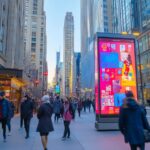In today’s competitive tourism landscape, understanding foot traffic analytics and visitor data is crucial for cities aiming to enhance their marketing strategies. By analyzing visitor flow through popular attractions, urban areas can identify trends and patterns, optimize resources, and improve the overall tourist experience. This article delves into the concept of foot traffic analytics, its importance for city tourism marketing, and practical methods for collecting and analyzing data. Discover how these insights can assist cities in attracting more visitors and elevating their tourism strategies.
Understanding Foot Traffic Analytics

Foot traffic analytics involves the systematic collection and analysis of movement patterns in public spaces concerning specific venues or areas. This field is essential for urban development and employs various methodologies to capture visitor behavior, enhance location intelligence, and improve pedestrian counting and footfall measurement.
As cities strive to refine their tourism strategies and marketing efforts, understanding foot traffic becomes crucial for stakeholders to make informed, data-driven decisions. Smart technology and real-time analytics offer urban planners valuable insights into consumer behavior, pedestrian patterns, and traffic patterns, which can be leveraged to benefit local businesses and foster community engagement.
What is Foot Traffic Analytics?
Foot traffic analytics involve measuring and analyzing the patterns of individuals moving within a specific area, providing valuable insights into their behavior and demographics. This analytical approach enhances data visualization, enabling a clearer understanding of visitor engagement and seasonal trends. By employing various tools and methodologies, foot traffic analytics yield demographic insights that help identify the needs of visitors and support urban planning.
Techniques such as GPS tracking, Wi-Fi signals, and video surveillance are utilized to gather data on foot traffic patterns. The significance of this analysis lies in its ability to reveal when people visit, the routes they take, and where congestion occurs. Such information is instrumental in making informed decisions regarding store placements, marketing strategies, resource allocation, and public safety.
Furthermore, advanced data visualization tools facilitate the easy interpretation of complex data sets, while a deeper understanding of visitor demographics enhances engagement strategies. Overall, foot traffic analytics play a crucial role in shaping business decisions and improving the visitor experience.
Importance of Foot Traffic Analytics for City Tourism Marketing

Foot traffic analytics plays a crucial role in city tourism marketing by providing valuable data that enhances marketing optimization, visitor management, and tourism strategies.
The insights gained from foot traffic analytics enable cities to measure the economic impact of tourism, understand popular tourist destinations, and allocate resources more effectively. Additionally, these insights can improve place branding and market segmentation.
By analyzing why and how long visitors stay in a city, marketers can tailor campaigns that align with tourists’ preferences, thereby improving retention rates, which are essential for sustainability and economic development.
For instance, a city equipped with foot traffic monitoring technology can identify peak visitation times for specific areas, allowing them to schedule events, community development initiatives, and promotions accordingly.
A notable example of this is New York City, which utilized foot traffic data to optimize its holiday marketing, resulting in improved visitor experiences and increased holiday foot traffic.
Similarly, a European city could leverage this information to direct funding towards areas that are not attracting enough visitors, enhancing local attractions.
By harnessing this data, cities can enhance visitor satisfaction and user experience while simultaneously supporting the growth of local businesses.
Collecting and Analyzing Foot Traffic Data
The collection and analysis of foot traffic data involve utilizing various methodologies and technologies to gather information about visitor movements and behaviors in urban environments. These methodologies include mobile tracking, behavioral analytics, and the use of geographic information systems.
By employing mobile tracking and pedestrian counting tools, city planners and marketers can access real-time analytics and engagement metrics that yield valuable data.
This process not only offers insights into current traffic patterns but also aids in shaping future urban and tourism development by providing accurate information on visitor movements and transit patterns.
Methods for Collecting Foot Traffic Data

Methods for collecting foot traffic data encompass both traditional pedestrian counting techniques and innovative mobile applications that track movement patterns. These approaches facilitate demographic profiling and spatial analysis, allowing stakeholders to gain a comprehensive understanding of visitor behavior, preferences, and travel trends.
By integrating qualitative and quantitative data collection techniques, cities can effectively measure overall foot traffic across various public spaces, leading to more informed tourism strategies.
Traditional techniques involve positioning handheld counters or cameras at strategic locations throughout the city to monitor and record the number of individuals passing through specific areas. In contrast, modern mobile applications utilize GPS and Bluetooth technology to anonymously track movements in real-time, providing valuable visitor insights.
This dual approach not only increases the volume of data collected but also helps establish correlations between foot traffic trends and specific demographic characteristics, such as age and gender differences, contributing to improved tourism analytics.
Spatial analysis, which visualizes data across different geographic regions, can significantly enhance site planning, event promotion, and event management by ensuring that public spaces are utilized effectively to meet the needs of the community.
Tools for Analyzing Foot Traffic Data
Analyzing foot traffic data necessitates a comprehensive suite of tools and technologies designed to process and interpret complex datasets, providing valuable insights for urban planners and marketers. Tools such as predictive analytics, heat maps, and interactive maps visualize traffic patterns and visitor behaviors, facilitating strategic resource allocation and informed marketing decisions.
By leveraging business intelligence platforms, cities can transform raw data into actionable insights that enhance the overall visitor experience and drive tourism campaigns, optimizing city infrastructure and public relations.
Plus these core tools, businesses often integrate advanced machine learning algorithms that refine predictions over time, ensuring their relevance as trends evolve. The use of real-time data collection methods, such as mobile tracking and online surveys, gives the power to marketers to quickly adapt strategies based on the latest insights.
The combined effect of these tools enables organizations to engage more effectively with their audiences, optimizing marketing efforts and guiding infrastructure investments. Ultimately, the synergy of predictive analytics, heat maps, and user-generated content not only aids in understanding foot traffic but also enhances community engagement and contributes to long-term planning initiatives.
Using Foot Traffic Analytics for City Tourism Marketing

Utilizing foot traffic analytics in city tourism marketing enables stakeholders to leverage essential visitor insights, which can shape effective marketing optimization strategies, improve tourism ROI, and enhance the overall visitor experience.
By analyzing foot traffic data, cities can identify trends that inform targeted tourism marketing campaigns aimed at specific demographic segments, resulting in increased visitor engagement and retention.
This data-driven decision-making process allows local businesses and tourism organizations to optimize resource allocation for marketing initiatives, ensuring that strategies align with actual visitor behavior and engagement metrics.
Identifying Popular Tourist Spots
Identifying popular tourist spots through foot traffic analytics involves analyzing visitor data and traffic patterns to pinpoint key hotspots within a city. By examining seasonality and peak visitor times, cities can gain insights into which attractions attract the most foot traffic, the economic impact, and the reasons behind it.
This information guides tourism marketing efforts, enabling stakeholders to promote high-traffic areas while also identifying opportunities to enhance the visitor experience at less frequented locations and improve overall tourism optimization.
Plus improving promotional strategies, the insights gained from foot traffic analytics can inform infrastructure development and resource allocation. For example, understanding visitor flow allows city planners to optimize amenities such as public transportation, restrooms, and information kiosks in areas where tourists are most concentrated, supporting smart tourism initiatives.
These data-driven approaches not only aid in managing crowds but also create tailored experiences that cater to diverse interests, fostering a richer and more satisfying visit for everyone involved. Ultimately, leveraging visitor data in this manner can transform the landscape of urban tourism, creating a more efficient and appealing environment, and fostering tourism innovation.
Optimizing Marketing Strategies
Optimizing marketing strategies through foot traffic analytics involves making data-driven decisions that tailor marketing campaigns to effectively reach the right audience. By understanding visitor demographics and behaviors, cities can develop improved tourism strategies and advertising methods that enhance visitor engagement and conversion rates. This approach not only boosts marketing effectiveness but also minimizes waste when promoting cultural attractions, events, and city navigation.
Pedestrian traffic analysis enables marketers to identify peak visiting hours and preferred locations for targeted promotions aimed at specific audience segments. By examining pedestrian patterns and visitor data, businesses can leverage insights from foot traffic analytics to create customized experiences tailored for families, solo visitors, or culture enthusiasts. Additionally, tourism analytics provides demographic insights which help refine marketing strategies.
Additionally, geofencing can enhance these efforts by delivering personalized deals directly to potential visitors as they approach a location, supported by location intelligence and mobile tracking technologies.
Furthermore, social media analytics can assist cities in reaching younger demographics by offering festival and event experiences that align with their preferences, ultimately contributing to a more comprehensive tourism marketing strategy through strategic use of engagement metrics and outreach initiatives.
Improving Tourist Experiences
Enhancing tourist experiences through foot traffic analytics is closely linked to improving overall tourism satisfaction. Understanding the needs, preferences, and tourist behavior is essential for effective visitor management and tourism optimization.
By utilizing wayfinding solutions and foot traffic analytics, cities can create more dynamic public spaces that facilitate visitor flow while promoting community engagement. This targeted approach ensures an enhanced visitor experience, leading to longer stays and repeat visits, which positively impacts local economies through increased tourism ROI and economic development.
To achieve this, destinations can leverage data-driven insights and spatial analysis to identify peak visiting times, popular routes, and congestion points. These insights enable tourism managers to implement targeted improvements such as better signage, seating areas, and visually appealing attractions that capture visitors’ attention and guide them toward lesser-known local attractions and experiences, boosting place branding and city tourism efforts.
Familiarity with the local business and residential landscape can also generate unique tourism experiences and storytelling opportunities that enrich the tourist experience. Engaging the community in this process fosters a sense of ownership and belonging, ensuring that both visitors and residents feel connected to their environment through enhanced community development and sustainable tourism practices.





